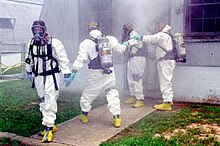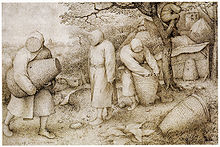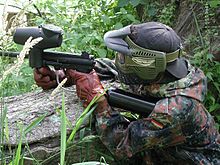Personal protective equipment

Personal protective equipment (PPE) refers to protective clothing, helmets, goggles, or other garments or equipment designed to protect the wearer's body from injury. The hazards addressed by protective equipment include physical, electrical, heat, chemicals, biohazards, and airborne particulate matter. Protective equipment may be worn for job-related occupational safety and health purposes, as well as for sports and other recreational activities. "Protective clothing" is applied to traditional categories of clothing, and "protective gear" applies to items such as pads, guards, shields, or masks, and others.
The purpose of personal protective equipment is to reduce employee exposure to hazards when engineering and administrative controls are not feasible or effective to reduce these risks to acceptable levels. PPE is needed when there are hazards present. PPE has the serious limitation that it does not eliminate the hazard at source and may result in employees being exposed to the hazard if the equipment fails.[1]
Any item of PPE imposes a barrier between the wearer/user and the working environment. This can create additional strains on the wearer; impair their ability to carry out their work and create significant levels of discomfort. Any of these can discourage wearers from using PPE correctly, therefore placing them at risk of injury, ill-health or, under extreme circumstances, death. Good ergonomic design can help to minimise these barriers and can therefore help to ensure safe and healthy working conditions through the correct use of PPE.
Practices of occupational safety and health can use hazard controls and interventions to mitigate workplace hazards, which pose a threat to the safety and quality of life of workers. The hierarchy of hazard control hierarchy of control provides a policy framework which ranks the types of hazard controls in terms of absolute risk reduction. At the top of the hierarchy are elimination and substitution, which remove the hazard entirely or replace the hazard with a safer alternative. If elimination or substitution measures cannot apply, engineering controls and administrative controls, which seek to design safer mechanisms and coach safer human behavior, are implemented. Personal protective equipment ranks last on the hierarchy of controls, as the workers are regularly exposed to the hazard, with a barrier of protection. The hierarchy of controls is important in acknowledging that while personal protective equipment has tremedous utility, it is not the desired mechanism of control in terms of worker safety.
PPE by type

Personal protective equipment can be categorized by the area of the body protected, by the types of hazard, and by the type of garment or accessory. A single item, for example boots, may provide multiple forms of protection: a steel toe cap and steel insoles for protection of the feet from crushing or puncture injuires, impervious rubber and lining for protection from water and chemicals, high reflectivity and heat resistance for protection from radiant heat, and high electrical resistivity for protection from electric shock. The protective attributes of each piece of equipment must be compared with the hazards expected to be found in the workplace.
Respirators

Respirators serve to protect the user from breathing in contaminants in the air, thus preserving the health of one's respiratory tract. There are two main types of respirators. One type of respirator functions by filtering out chemicals and gases or airborne particles from the air breathed by the user.[2] Gas masks and particulate respirators are examples of this type of respirator. A second type of respirator protects users by providing clean, respirable air from another source. This type includes airline respirators and self-contained breathing apparatus (SCBA).[2] In work environments, respirators are relied upon when adequate ventilation is not available or other engineering control systems are not feasible or inadequate.[2]
In the United Kingdom, an organization that has extensive expertise in respiratory protective equipment is the Institute of Occupational Medicine. This expertise has been built on a long-standing and varied research programme that has included the setting of workplace protection factors to the assessment of efficacy of masks available through high street retail outlets.
The Health and Safety Executive (HSE), NHS Health Scotland and Healthy Working Lives (HWL) have jointly developed the RPE (Respiratory Protective Equipment) Selector Tool, which is web-based. This interactive tool provides descriptions of different types of respirators and breathing apparatuses, as well as "do's and dont's" for each type.[3]
In the United States, The National Institute for Occupational Safety and Health (NIOSH) provides recommendations on respirator use, in accordance to NIOSH federal respiratory regulations 42 CFR Part 84.[2] The National Personal Protective Technology Laboratory (NPPTL) of NIOSH is tasked towards actively conducting studies on respirators and providing recommendations.[4]
Skin protection

Occupational skin diseases such as contact dermatitis, skin cancers, and other skin injuries and infections are the second most common type of occupational disease and can be very costly.[5] Skin hazards, which lead to occupational skin disease, can be classified into four groups. Chemical agents can come into contact with the skin through direct contact with contaminated surfaces, deposition of aerosols, immersion or splashes.[5] Physical agents such as extreme temperatures and ultraviolet or solar radiation can be damaging to the skin over prolonged exposure.[5] Mechanical trauma occurs in the form of friction, pressure, abrasions, lacerations and contusions.[5] Biological agents such as parasites, microorganisms, plants and animals can have varied effects when exposed to the skin.[5]
Any form of PPE that acts as a barrier between the skin and the agent of exposure can be considered skin protection. Because a lot of work is done with the hands, gloves are an essential item in providing skin protection. Some examples of gloves commonly used as PPE include rubber gloves, cut-resistant gloves, chainsaw gloves and heat-resistant gloves. For sports and other recreational activities, many different gloves are used for protection, generally against mechanical trauma.
Other than gloves,any other article of clothing or protection worn for a purpose serve to protect the skin. Lab coats for example, are worn to protect against potential splashes of chemicals. Face shields serve to protect one's face from potential impact hazards, chemical splashes or possible infectious fluid.
Eye protection

Each day, about 2000 US workers have a job-related eye injury that requires medical attention.[6] Eye injuries can happen through a variety of means. Most eye injuries occur when solid particles such as metal slivers, wood chips, sand or cement chips get into the eye.[6] Smaller particles in smokes and larger particles, such as broken glass also account for particulate matter causing eye injuries. Blunt force trauma can occur to the eye when excessive force comes into contact with the eye. Chemical burns, biological agents, and thermal agents, from sources such as welding torches and UV light also contribute to occupational eye injury.[7]
While the recommended usage of eye protection varies by occupation, the provision of safety furnished by said piece of equipment can be generalized. Safety glasses provide minimum protection from external debris, and are recommended to provide side protection via a wrap-around design or via side shields.[7] Goggles provide better protection than safety glasses, and are effective in preventing eye injury from chemical splashes, impact, dusty environments and welding.[7] It is recommended that goggles with high air flow be used, in order to prevent fogging.[7] Face shields are a useful form of additional protection to be worn over the standard eyewear, and provide protection from impact, chemical, and blood-borne hazards.[7] Full-facepiece respirators are considered the best form of eye protection when respiratory protection is needed as well, but may be less effective against potential impact hazards to the eye.[7] Eye protection used for welding operations is shaded to different degrees, depending on the specific operation.[7]
Hearing protection
Industrial noise is often overlooked as an occupational hazard, as it is not visible to the eye. Overall, about 22 millions workers in the United States are exposed to potentially damaging noise levels each year.[8] Occupational hearing loss accounted for 14% of all occupational illnesses in 2007, with about 23,000 cases significant enough to cause permanent hearing impairment.[8] About 82% of occupational hearing loss cases occurred to workers in the manufacturing sector.[8] The Occupational Safety and Health Administration establishes occupational noise exposure standards.[9] NIOSH recommends that worker exposures to noise be reduced to a level equivalent to 85 dBA for eight hours to reduce occupational noise induced hearing loss.[10]
PPE for hearing protection consists of earplugs and earmuffs. Workers who are regularly exposed to noise levels above the NIOSH recommendation should be furnished hearing protection by the employers, as they are a low-cost internvetion.
Protective clothing and ensembles

This form of PPE is all-encompassing and refers to the various suits and uniforms worn to protect the user from harm. Lab coats worn by scientists and ballistic vests worn by law enforcement officials, which are worn on a regular basis, would fall into this category. Entire sets of PPE, worn together in a combined suit, would also fall into this category.
Ensembles
Below are some examples of ensembles of personal protective equipment, worn together for a specific occupation or task, to provide maximum protection for the user.
- Chainsaw protection (especially a helmet with face guard, hearing protection, kevlar chaps, anti-vibration gloves, and chainsaw safety boots). Specific information about chainsaw protection appears in the chainsaw safety clothing article.
- Bee-keepers wear various levels of protection depending on the temperament of their bees and the reaction of the bees to nectar availability. At minimum most bee keepers wear a brimmed hat and a veil made of hardware cloth similar to window-screen material. The next level of protection involves leather gloves with long gauntlets and some way of keeping bees from crawling up one's trouser legs. In extreme cases, specially-fabricated shirts and trousers can serve as barriers to the bees' stingers.
- Diving equipment, for underwater diving, constitute of equipment such as a diving mask, an underwater breathing apparatus, a diving suit or wetsuit, and flippers.
- Firefighters wear PPE designed to provide protection against fires and various fumes and gases. PPE worn by firefighters include bunker gear, self-contained breathing apparatus, a helmet, safety boots, and a PASS device.
PPE in sports
Participants in sports often wear protective equipment. Studies performed on the injuries of professional athletes, such as that on NFL players,[11][12] question the effectiveness of existing personal protective equipment.
Limits of the definition

The definition of what constitutes as personal protective equipment varies by country. In the United States, the laws regarding PPE also varies by state. In 2011, workplace safety complaints were brought against Hustler and other adult film production companies by the AIDS Healthcare Foundation, leading to several citations brought by Cal/OSHA.[13] The failure to use condoms by adult film stars was a violation of Cal/OSHA's Blood borne Pathogens Program, Personal Protective Equipment.[13] This example shows that personal protective equipment can cover a variety of occupations in the United States, and has a wide-ranging definition.
Legislation in the European Union
At the European Union level, personal protective equipment is governed by Directive 89/686/EEC on personal protective equipment (PPE). The Directive is designed to ensure that PPE meets common quality and safety standards by setting out basic safety requirements for personal protective equipment, as well as conditions for its placement on the market and free movement within the EU single market. It covers ‘any device or appliance designed to be worn or held by an individual for protection against one or more health and safety hazards’.[14] The directive was adopted on 21 January 1989 and came into force on 1 July 1992. The European Commission additionally allowed for a transition period until 30 June 1995 to give companies sufficient time to adapt to the legislation. After this date, all PPE placed on the market in EU Member States was required to comply with the requirements of Directive 89/686/EEC and carry the CE Marking.
Article 1 of Directive 89/686/EEC defines personal protective equipment as any device or appliance designed to be worn or held by an individual for protection against one or more health and safety hazards. PPE which falls under the scope of the Directive is divided into three categories:
- Category I: simple design (e.g. gardening gloves, footwear, ski goggles)
- Category II: PPE not falling into category I or III (e.g. personal flotation devices, dry and wet suits)
- Category III: complex design (e.g. respiratory equipment, harnesses)
Directive 89/686/EEC on personal protective equipment does not distinguish between PPE for professional use and PPE for leisure purposes.
Personal protective equipment falling within the scope of the Directive must comply with the basic health and safety requirements set out in Annex II of the Directive. To facilitate conformity with these requirements, harmonized standards are developed at the European or international level by the European Committee for Standardization (CEN, CENELEC) and the International Organization for Standardization in relation to the design and manufacture of the product. Usage of the harmonized standards is voluntary and provides presumption of conformity. However, manufacturers may choose an alternative method of complying with the requirements of the Directive.
Personal protective equipment excluded from the scope of the Directive includes:
- PPE designed for and used by the armed forces or in the maintenance of law and order;
- PPE for self-defence (e.g. aerosol canisters, personal deterrent weapons);
- PPE designed and manufactured for personal use against adverse atmospheric conditions (e.g. seasonal clothing, umbrellas), damp and water (e.g. dish-washing gloves) and heat;
- PPE used on vessels and aircraft but not worn at all times;
- helmets and visors intended for users of two- or three-wheeled motor vehicles.
The European Commission is currently working to revise Directive 89/686/EEC. The revision will look at the scope of the Directive, the conformity assessment procedures and technical requirements regarding market surveillance. It will also align the Directive with the New Legalislative Framework. The European Commission is likely to publish its proposal in 2013. It will then be discussed by the European Parliament and Council of the European Union under the ordinary legislative procedure before being published in the Official Journal of the European Union and becoming law.
Gallery
-
Members of FEMA wear PPE to protect against radioactive hazards.
-
Worker wearing a face shield, a helmet Tyvek coveralls, gloves, and earplugs while decontaminating a containment boom.
-
Rescue worker wearing a half-mask respirator.
-
Riot officer dressed in armor to protect against impacts.
-
National Hockey League goaltender wearing the required PPE to play.
-
Trawl fishermen wearing brightly-colored personal flotation devices to protect against drowning.
See also
- Biohazard
- Bomb disposal
- Chainsaw safety clothing
- Environmental suit
- Hard hat
- Hazmat (hazardous materials)
- High-visibility clothing
- Lifejacket
- Motorcycle safety clothing
- NBC suit
- Personal protective equipment for arc flash
- Safe handling of hazardous drugs
- Safety harness
- Usage of personal protective equipment
External links
- CDC - Personal Protective Equipment - NIOSH Workplace Safety and Health Topic
- European Commission, DG Enterprise, Personal Protective Equipment
- Directive 89/686/EEC on Personal Protective Equipment
- A short guide to the Personal Protective Equipment at Work Regulations 1992' INDG174(rev1), revised 8/05 (HSE).
References
- ^ http://www.citation.co.uk/health-and-safety/personal-protective-equipment Personal Protective Equipment
- ^ a b c d Respirators. National Institute for Occupational Safety and Health.
- ^ RPE Selector. Healthy Working Lives.
- ^ CDC - NIOSH - Respirator Fact Sheet. The National Personal Protective Technology Laboratory.
- ^ a b c d e CDC - Skin Exposures and Effects - NIOSH Workplace Safety and Health Topic. The National Institute for Occupational Safety and Health.
- ^ a b CDC - Eye Safety - NIOSH Workplace Safety and Health Topic. The National Institute for Occupational Safety and Health.
- ^ a b c d e f g CDC - Eye Safety - Eye Safety for Emergency Response and Disaster Recovery. The National Institute for Occupational Safety and Health.
- ^ a b c CDC - Noise and Hearing Loss Prevention - Facts and Statistics - NIOSH Workplace Safety and Health Topic. The National Institute for Occuaptional Safety and Health.
- ^ Occupational noise exposure - 1910.95. The Occupational Safety and Health Administration.
- ^ Criteria for a Recommended Standard: Occupational Noise Exposure. DHHS (NIOSH) Publication No. 98-126.
- ^ CDC - NIOSH Science Blog - Brain Injury in the NFL. The National Institute for Occupational Safety and Health.
- ^ Lehman, EJ; Hein, MJ; Baron, SL; Gersic, CM (2012). "Neurodegenerative causes of death among retired National Football League players". Neurology. American Academy of Neurology. doi:10.1212/WNL.0b013e31826daf50. Retrieved 20 September 2012.
- ^ a b Larry Flynt's Hustler Video Cited by Cal/OSHA over Condoms, Safety, Says AHF | Business Wire.
- ^ Article 1, Directive 89/686/EEC on personal protective equipment






